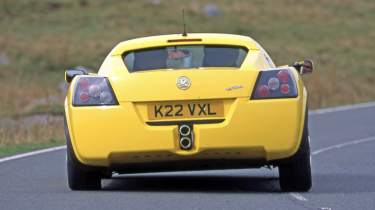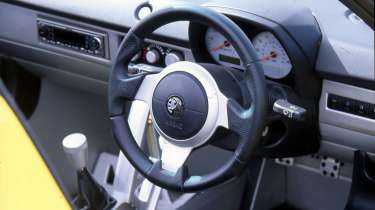Used Vauxhall VX220 (2000-2005) buyer’s guide
A full used buyer’s guide on the Vauxhall VX220, which was on sale between 2000 and 2005
Verdict
Selling alongside such gems as the Agila, Vectra and Frontera, the Vauxhall VX220 was at one end of the spectrum, while the rest of the Vauxhall catalogue was at the other. Created to inject some glamour into the rest of the Vauxhall range, the VX220 was just the shot in the arm that the brand needed. At the time this brilliant roadster was held back by the badge on its nose, but nowadays things have changed radically, with the VX220 now extremely collectable. Sports cars like the VX220 have pretty much died out now, and under Stellantis it’s clear that Vauxhall will never make anything like this brilliant roadster, not least because of the focus on electric cars. That’s a shame, because the VX220 injected some sex appeal into Vauxhall’s otherwise uninspiring model range.
Great driver’s cars tend to be costly to buy and run, but occasionally an exception to this rule comes along, and that’s the case with the Vauxhall VX220. It’s a brilliant model for the driving enthusiast, which is also affordable to buy and own.
Produced alongside the Lotus Elise, the Vauxhall VX220 never enjoyed the same cachet as its cousin. Yet not only is the VX220 more usable in some ways, it’s also every bit as exciting to drive.
Used - available now

2023 Ford
Focus
13,377 milesManualPetrol1.0L
Cash £17,989
2022 Ford
Focus
8,380 milesManualPetrol1.0L
Cash £19,236
2021 Ford
Focus
21,356 milesManualPetrol1.0L
Cash £16,555
2023 Ford
Kuga
25,148 milesManualPetrol1.5L
Cash £19,440However, the word is out about what a great car the VX220 is, and values have risen accordingly. Before they soar out of reach altogether, investing in a VX220 might be just the ticket for some summer fun.
History
The VX220 appeared in August 2000, with a normally aspirated all-alloy 2.2-litre four-cylinder engine. The following year the special-edition Lightning Yellow arrived; 100 were built, with bright-yellow paint, anthracite alloy wheels and a colour-coded hard top, but with no mechanical changes.
An even faster model appeared in December 2002: the Turbo. With a 197bhp 2.0-litre engine and a tweaked chassis, the Turbo is quicker and has a better-balanced chassis. But the pick of the bunch is the VXR220 from 2004. Just 65 examples of this run-out special were built, each with a 2.0-litre turbo engine packing 220bhp.
Which one should I buy?
Even the naturally aspirated VX220 can crack 0-62mph in just 5.6 seconds, with the Turbo able to knock almost a second off this time; it has 197bhp compared with the 145bhp output of the 2.2-litre version.
It’s the Turbo’s in-gear times that really impress, though, and things are helped by the car’s low 930kg kerbweight. Whichever model you go for, equipment levels were sparse. Electric windows were standard, but a CD player was optional, as were two-tone leather trim, a hard-top, remote central locking and a passenger footrest. A Touring Pack was offered, which added carpeted sills and extra soundproofing.
Many VX220s have been modified, with common upgrades including remapped ECUs and aftermarket exhausts, plus brake and suspension improvements. Many of these changes are desirable, but the quality of some leaves a lot to be desired.
Alternatives to the Vauxhall VX220
The only genuine rival to the VX220 is the Lotus Elise. The S1 is even better to drive than the S2, but the newer car is more civilised and built to a higher standard. All S1s and earlier S2s featured a Rover K-Series engine, but from 2005 a 1.8-litre Toyota powerplant was installed instead.
That engine was fitted to the MR2 Mk3, which is another VX220 alternative that’s less usable than you might expect, thanks to its mid-engined configuration. It’s great fun and much cheaper than the Vauxhall. The same goes for the MG F and TF, also powered by mid-mounted 1.8-litre engines, which cost less to buy than the VX220, too.
Don’t overlook the evergreen Mazda MX-5, either. The two-seater is plentiful, great to drive, temptingly priced and also much more usable than the Vauxhall.
What to look for
Cooling
The radiators were poorly made. Alloy replacements are common, but many of these are cheaply produced, so check for leaks.
Alignment
Whether you’re driving your VX220 on road or track, the suspension geometry needs to be set up correctly. It can transform things.
Prangs
A lot of VX220s have been crashed, so get underneath to look for chassis and suspension damage, plus check for uneven tyre wear.
Spare parts
All service items are readily available, but anything bespoke to the VX220 probably isn’t, so beware of any car in need of work.
Interior
Getting in and out is tricky, thanks to the wide sills and the VX220 being so low-slung. But once you’re in, it’s surprisingly comfortable considering that the cabin is just about as far from luxurious as it’s possible to be. There’s lots of bare metal, and no carpet was fitted as standard, which means VX220 interiors get scuffed all too easily.
The door trims are flimsy and the roof can leak; Turbo editions are better in this respect and earlier cars can be upgraded accordingly. If the doors shake, their retaining pins need to be adjusted, but that’s an easy job for a specialist. Boot space is at a premium, with just 206 litres available; that’s enough for two small soft bags.
Prices
It’s the VXR220 that everyone wants, but they rarely come up for sale. If you’re tempted by one, make sure it’s the real thing by checking for its black Speedline alloys, VXR branding for the interior, and an all-black grille and windscreen surround.
To check prices on a specific model head over to our valuation tool.
Running costs
Most of the VX220’s running gear is shared with more mainstream Vauxhall models of the time, such as the Astra, so parts availability is good. But official dealers no longer offer support, which means that you’ll need to find a good independent specialist, such as Courtenay Sport in North Walsham, Norfolk.
The Vauxhall VX220 needs to be serviced every 12 months or 10,000 miles, with maintenance alternating between Minor and Major check-ups, priced at £189 and £241 respectively. On top of this, the brake fluid needs to be renewed every three years, at a cost of £78, or £95 for race-spec fluid. While the 2.2-litre engine doesn’t have a cambelt, the 2.0 Turbo engine does, and this needs to be replaced every four years or 40,000 miles, at a cost of £340.
Recalls
Vauxhall recalled the VX220 on three occasions, with the first two campaigns issued on the same day in September 2002. The first affected 729 cars that left the factory with faulty driver’s airbags, the material of which could crack so it didn’t inflate properly. The only solution was to replace the airbag altogether.
The other recall issued on that day related to the brake calipers, the bolts for which may not have done their job correctly because of a manufacturing fault. This time just 31 VX220s were affected.
Vauxhall’s third and final campaign for the model came in July 2006, because 806 VX220s made from the start of 2001 until the end of 2002 had left the factory with sub-standard wheels, which could crack. To fix the problem, dealers fitted new rims if necessary.
Driver Power owner satisfaction
The VX220 never appeared in our Driver Power surveys and as a car that’s now outside the dealer network, it’s one that requires you to do your homework very carefully before buying. It’s not unusual for a VX220 to go through several owners in quick succession, because they love the driving experience, looks and potential economy, but can’t live with the Vauxhall’s shortage of practicality or refinement.










